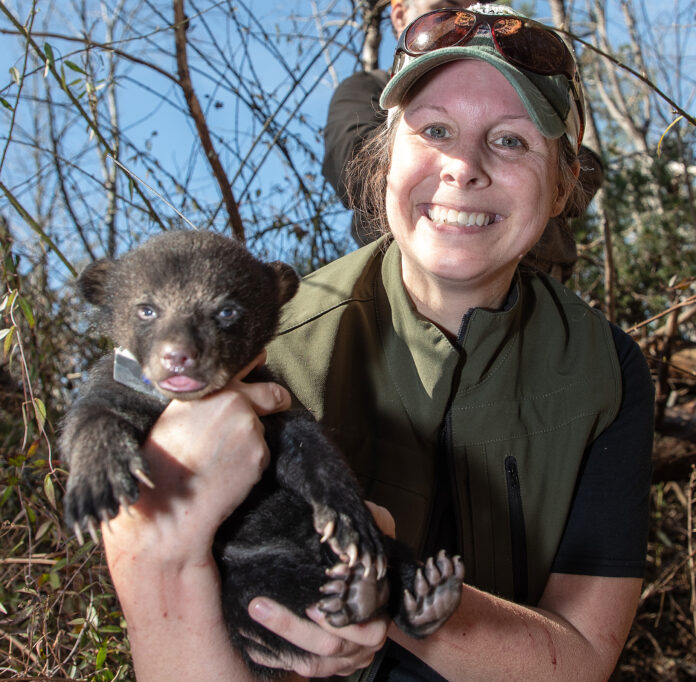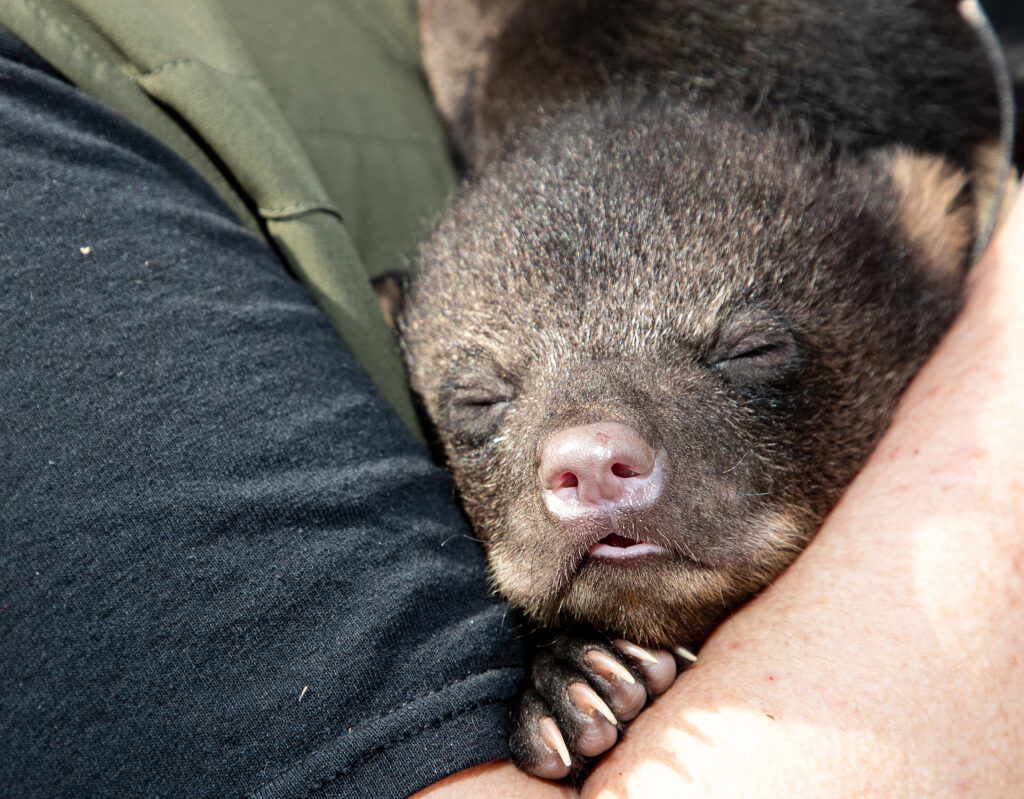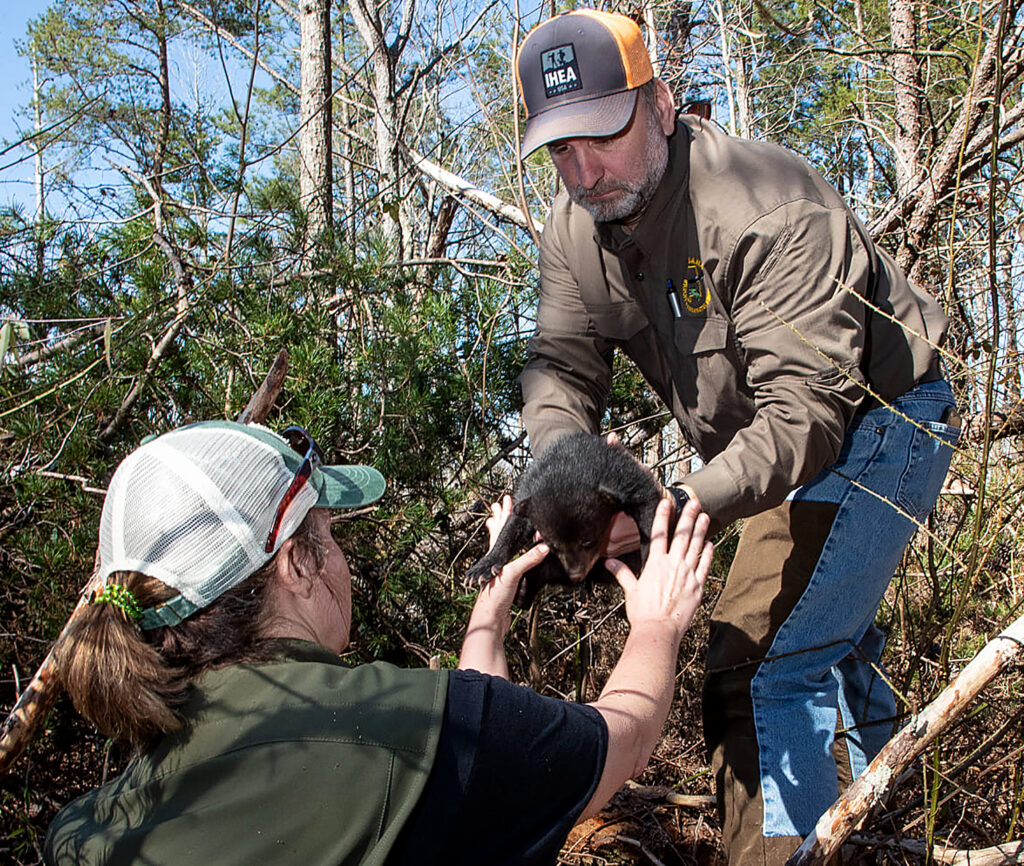
MONTGOMERY, Ala. – To say Traci Wood has a passion for bears would understate her love for the small black bear populations on opposite ends of the state in northeast and southwest Alabama.
Wood, State Wildlife Grants coordinator with the Alabama Department of Conservation and Natural Resources’ (ADCNR) Wildlife and Freshwater Fisheries (WFF) Division, recently was among a team of biologists and researchers who were able to place collars on a trio of bear cubs in DeKalb County near Mentone.
A research program under State Wildlife Grants is continuing to monitor the black bear populations in the state. In its fourth year, the study looks at cub survival and den habitat.
“We’re evaluating the types of den structures the sows are using,” Wood said. “We are collaring cubs when they are 7 weeks of age, around the 5-pound mark. It’s basically a GPS collar. We also insert a PIT (Passive Integrated Transponder) tag into them. That collar expands as they grow. After six to nine months, that collar will fall off. So, if we trap that animal later, the PIT tag will identify as a cub we had previously collared.
“What that collar also tells us is if that cub has died. If they die, we receive a transmitter signal, and we can find the location of the den and try to determine the cause of death. This will give an indication of how cubs are recruiting into the population.”
When the cubs become adults and are collared again, the research team gathers a great deal more information about bear habits and habitat.
“It tells us where they are going, if they’re having cubs in the future,” Wood said. “Hopefully, it’s a long-term look at the life ecology of a bear from when it’s born to its reproductive age.”
The previous summer, WFF and the Auburn University research team, with Hannah Leeper as the research associate in the field, trapped females and attached GPS collars to determine where they made their winter dens. With the dens located, the team was able to find the cubs this spring near Mentone.
The team will move to the Mobile area this weekend to start performing den checks to hopefully find cubs to collar.

“The cubs in southwest Alabama are born at different times than north Alabama cubs,” Wood said. “We really don’t know why. It could be due to genetic reasons. Those cubs should be big enough to attach cub collars.”
Although the study is focused on the bear populations in those two areas, Wood said that doesn’t mean bears aren’t denning and birthing cubs in other areas of the state.
When den locations are determined, the researchers carefully approach the den to determine if the sow has given birth.
“When we approach, the mom usually gets off the den and runs off right away,” Wood said. “We go straight into the den, collar, weigh and measure the cubs and put them back. It’s a very quick process because we want to reduce the stress to the den and mom. We want her to come back as quickly as possible. We don’t want her to think we are a threat.
“She usually comes back within an hour, which is kind of surprising. I think she can sense – hear and smell – when we’re gone. That’s good news the sows are returning to the dens. Later, with the GPS, we can determine if the mom stayed at the den, or she may move her cubs to a different den.
“A couple of weeks after we collar the cubs, they are out of the den, walking around with mom. They’re big enough to keep up with mom, and they’re exploring and climbing trees.”
Wood said the bear population in northeast Alabama is doing great with sows producing large litters.
“It’s not uncommon to encounter three cubs on average in a den,” she said. “Those cubs are very healthy, look very pretty, and they’re surviving in that first year, which is the most critical period because they’re small, vulnerable to predators, and it is a lot of work to keep up with mom.
“Those cubs in north Alabama have very good habitat as well. They have canyons, caves and rock outcrops. Because of the canyons, they’re not running into people, houses or barriers. Even though we’re not seeing many sows’ dens in caves, most of the time they den in windrows after a tree cutting. It’s very thick. That seems to be their preference. It’s very removed from people as well. We’re seeing high cub survival in north Alabama.”
After about a year, the yearlings will disperse, and Wood said some of the males travel into Georgia.
“They’re covering a very large range,” she said. “It’s a bigger picture than what you would think. The linkage between our bears in northeast Alabama and Georgia has very high potential because of the good habitat in that corridor.”
Unfortunately, the bear population in the Mobile area is facing many more hurdles to viability, mainly due to isolation and habitat.
“In the Mobile population, we are seeing more cub mortality,” Wood said. “It’s still a question mark for us on how to find answers and come up with solutions. They are a very genetically isolated population. They are surrounded by highways, the interstate and subdivisions. It has led to inbreeding and very low genetic diversity. It doesn’t bode well for them at all.
“Den habitat and habitat quality for the adult bears are not there. Their den is open, like a nest on the ground. There’s rarely coverage, exposing them to all the elements, not only predators but extreme weather like flooding in the (Mobile-Tensaw) Delta. All those factors play a part in cub survival. It doesn’t appear, at this stage of the project, that predators are the problem. It’s directly linked to the poor habitat. It leaves those cubs so vulnerable. They have a hard life from the get-go. But we’re trying to find the answers on how to protect that population.”
Wood said Auburn University has been a WFF partner for about a decade in this research on black bears, Alabama’s state mammal. Auburn leads the field work, trapping, collaring and tracking the bears as well as analyzing the data to provide a report to WFF.
“This assists us in making management decisions for bears,” she said. “It helps us evaluate the status of black bears in Alabama. It’s very important work.”
WFF and Auburn estimate the population of the northeast Alabama bears at 30-35 individuals. The southwest Alabama bear population is estimated at about 125 individuals, although Wood said some people in southwest Alabama think bears are everywhere.
“There aren’t as many bears in the Mobile population as people think,” she said. “They’re seeing the same bears over and over. The fact that they have such a restricted home range in the Mobile population means those bears are basically traveling in a circle with a radius of about 10 miles. Bears are a common sight in the general Saraland area.”
However, Wood said a black bear could be spotted just about anywhere in the state, especially during the summer months.
“Once the mom kicks them out at about 18 months of age, the young adult males roam,” she said. “But it’s not only the yearlings but older bears as well. The males are probably going to be looking for a mate or looking for a new home range. They can travel 250 miles.
“We’re starting to get more reports from the Birmingham area. Some of the north Alabama males come down that corridor and turn up around Birmingham and Alexander City.”

Wood said it’s important to be “Bear Aware” and realize any sighting during the summer is likely going to be a male bear passing through.
“If you have garbage out or you’re feeding wildlife, you should remove that food source for about two weeks, and the bear will move along,” she said. “Their activity is extremely food driven. They’re like little teenagers and get into trouble. Removing the food source is the key.
“But treat the bears as wildlife. Treat them as if they are dangerous. Typically, they’re not aggressive. They’re just looking for something to eat. You don’t want it to imprint on your food source because it’s going to keep coming back. That’s when it becomes a problem, but it’s more of a human problem than a bear problem.”
Wood hopes being “Bear Aware” will reduce human conflicts and people can enjoy just seeing a bear.
Speaking of bear sightings, WFF has set up an online reporting system for citizens. Visit: https://www.outdooralabama.com/black-bear/alabama-black-bears and click on the “Report a Black Bear Sighting” link at the top of the page.
“This helps us know where bears are popping up,” Wood said. “This helps us in where our research is focused. It helps us work with our citizens on how to be ‘Bear Aware.’
“People love bears because the cubs are so cute, but it’s not all rainbows and sunshine. It’s briars, mud and mosquitoes. It’s extremely hard work, but I love it.”

















